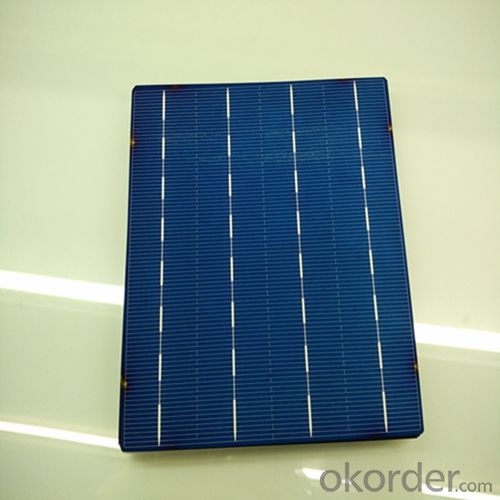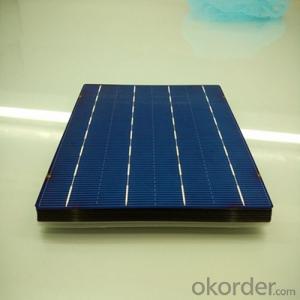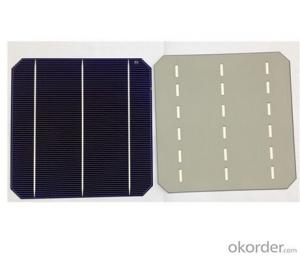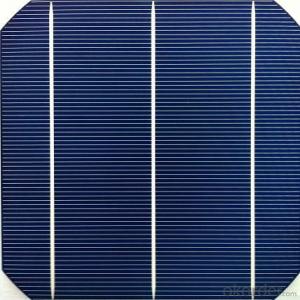Ribbon Silicon Solar Cells - Mono 156x156mm2 Made in China
- Loading Port:
- Shanghai
- Payment Terms:
- TT OR LC
- Min Order Qty:
- 6500 watt
- Supply Capability:
- 650000 watt/month
OKorder Service Pledge
OKorder Financial Service
You Might Also Like
Benefits of Solar Power:
Now is a great time to go solar and harvest the power of the sun. Here is our top ten list of the benefits to installing solar power:
When installed, solar energy is free – no resources are consumed
Help to lessen our dependence on heavily polluting coal power stations
Fossil fuels can't last forever, future generations will appreciate the effort
Characteristic of Mono 156X156MM2 Solar Cells
You are gaining energy independence - add battery backup power for even greater energy security
The cost of electricity is only going to rise – insure against that rising cost
Quality solar power and water adds value and appeal to your home
Specifications of Mono 156X156MM2 Solar Cells
Solar PV systems are easily upgraded in future - aim to make your house a net energy producer!
Solar panels offer a long lifetime of low maintenance service, maybe 30-40 years
Your friends will think you're great!
You'll feel great for doing your bit for the environment!
Mechanical data and design
Format | 156mm x 156mm±0.5mm |
Thickness | 210μm±40μm |
Front(-) | 1.5mm bus bar (silver),blue anti-reflection coating (silicon nitride) |
Back (+) | 2.5mm wide soldering pads (sliver) back surface field (aluminium) |
Temperature Coefficient of Cells
Voc. Temp.coef.%/K | -0.35% |
Isc. Temp.coef .%/K | +0.024%/K |
Pm.Temp.coef. %/K | -0.47%/K |
Electrical Characteristic
Effiency(%) | Pmpp(W) | Umpp(V) | Impp(A) | Uoc(V) | Isc(A) | FF(%) |
18.35 | 4.384 | 0.526 | 8.333 | 0.63 | 8.877 | 78.39% |
18.20 | 4.349 | 0.526 | 8.263 | 0.63 | 8.789 | 78.54% |
18.05 | 4.313 | 0.525 | 8.216 | 0.63 | 8.741 | 78.32% |
17.90 | 4.277 | 0.524 | 8.161 | 0.625 | 8.713 | 78.04% |
17.75 | 4.241 | 0.523 | 8.116 | 0.625 | 8.678 | 77.70% |
17.60 | 4.206 | 0.521 | 8.073 | 0.625 | 8.657 | 77.36% |
17.45 | 4.170 | 0.519 | 8.039 | 0.625 | 8.633 | 76.92% |
17.30 | 4.134 | 0.517 | 8.004 | 0.625 | 8.622 | 76.59% |
17.15 | 4.096 | 0.516 | 7.938 | 0.625 | 8.537 | 76.80% |
17.00 | 4.062 | 0.512 | 7.933 | 0.625 | 8.531 | 76.18% |
16.75 | 4.002 | 0.511 | 7.828 | 0.625 | 8.499 | 75.34% |
16.50 | 3.940 | 0.510 | 7.731 | 0.625 | 8.484 | 74.36% |





FAQ
Q: What price for each watt?
A: It depends on the quantity, delivery date and payment terms, generally Large Quantity and Low Price
Q: What is your size for each module? Can you tell me the Parameter of your module?
A: We have different series of panels in different output, both c-Si and a-Si. Please take the specification sheet for your reference.
Q: What is your size for each module? Can you tell me the Parameter of your module?
A: We have different series of panels in different output, both c-Si and a-Si. Please take the specification sheet for your reference.
- Q: Can solar cells be used for powering concert venues?
- Yes, solar cells can be used for powering concert venues. Solar cells, also known as photovoltaic cells, convert sunlight into electricity. Concert venues typically require a significant amount of energy for lighting, sound systems, and other equipment. By installing solar panels on the venue's roof or in nearby open spaces, the electricity generated can be used to power the venue. This not only reduces dependence on fossil fuels but also helps to lower energy costs and minimize the venue's carbon footprint.
- Q: What is the impact of algae growth on solar cell performance?
- The impact of algae growth on solar cell performance is generally negative. Algae growth can block sunlight from reaching the solar cells, reducing their efficiency and energy output. Additionally, algae can cause corrosion and damage to the surface of solar panels, further compromising their performance. Regular cleaning and maintenance are necessary to prevent algae buildup and ensure optimal solar cell performance.
- Q: What is the impact of dust and dirt on solar cell efficiency?
- Dust and dirt can have a significant impact on solar cell efficiency. When dust and dirt accumulate on the surface of solar cells, they block sunlight from reaching the cells, reducing their ability to generate electricity. This decrease in solar cell efficiency can lead to a decrease in overall power output and, consequently, a decrease in the overall efficiency of a solar panel or system. Regular cleaning and maintenance of solar panels are necessary to ensure optimal performance and maximize energy production.
- Q: Is it possible to learn how to make solar cells by yourself?
- I did that when I was 15 years old, and I succeeded!
- Q: Can solar cells be used in agriculture?
- Yes, solar cells can be used in agriculture. They can be used to power irrigation systems, lighting for greenhouses, and other agricultural equipment, helping to reduce reliance on traditional energy sources and promoting sustainable farming practices. Additionally, solar panels can be installed on agricultural buildings to generate electricity, providing a renewable energy source for farming operations.
- Q: What is the impact of solar cells on reducing electricity bills?
- Solar cells have a significant impact on reducing electricity bills as they generate renewable energy from the sun, which can be used to power homes or businesses. By harnessing solar power, individuals can reduce their reliance on traditional electricity sources, resulting in lower monthly bills. Additionally, excess energy produced by solar cells can be fed back into the grid, earning credits or payments that further offset electricity costs. Overall, solar cells provide a sustainable and cost-effective solution for reducing electricity bills.
- Q: Can solar cells be used for water heating applications?
- Yes, solar cells can be used for water heating applications. Solar thermal panels, also known as solar water heaters, use solar energy to heat water directly. However, it's important to note that solar cells, which convert sunlight into electricity, are typically used to generate electricity rather than directly heating water.
- Q: Can solar cells be used to power data centers?
- Yes, solar cells can be used to power data centers. With advancements in solar technology, it is possible to generate a significant amount of electricity from solar panels, making them a viable option for powering energy-intensive facilities like data centers. However, due to the high energy demands of data centers, it may require a large-scale solar installation and efficient energy storage systems to ensure uninterrupted power supply.
- Q: Are solar cells safe for the environment?
- Yes, solar cells are safe for the environment. They generate electricity by converting sunlight into clean energy, emitting no greenhouse gases or air pollutants during operation. Additionally, the production and installation of solar cells have minimal environmental impact compared to conventional energy sources.
- Q: Can somebody list some of the materials used for making solar cells?
- There are quite many materials to make a solar cell, but silicon is something you need to have.
Send your message to us
Ribbon Silicon Solar Cells - Mono 156x156mm2 Made in China
- Loading Port:
- Shanghai
- Payment Terms:
- TT OR LC
- Min Order Qty:
- 6500 watt
- Supply Capability:
- 650000 watt/month
OKorder Service Pledge
OKorder Financial Service
Similar products
Hot products
Hot Searches
Related keywords































